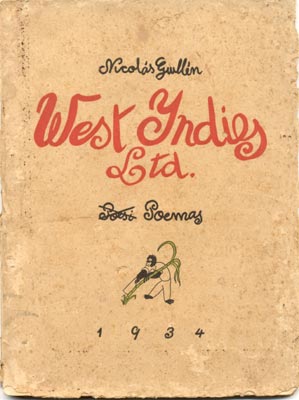4.1.1.14.3 The poetic work “West-Indies Ltd”, 1934, by Nicolás Guillén

From a thematic point of view, this work embodies the impotence of the republican era, already saturated with the frustration of the revolutionary effort around 1930, so that the imperialist accent becomes a cry of protest experienced as futile, one of the most difficult moments in Guillén’s history as a creator and revolutionary.
In this work, the black theme is more historically rooted than traditionalist; the exploitative essence of Yankee projects for America connects with the theme of the scourge of slavery, motivated by similar interests. Anti-imperialism reaches a high pitch here and is present as a connotative value in many of the pieces that make up the collection.
The poem “Sensemayá; song to kill a snake,” seemingly simple in structure, perhaps alludes precisely to the profound eradication of North American colonialism, with verses that can be read with a quasi-warlike sense, like a coded spell or war chant in the language of Black people, with the triple iteration of the lexical group “Mayombe-bombe-mayombé,” more than a simple jitanjaforic game.
This text contains the well-known “Ballad of the Two Grandfathers”, from which a fragment is reproduced:
“Shadows that only I see,
I am escorted by my two grandparents.
(…)
Bare foot, stony torso
my black ones;
Antarctic glass pupils
my white ones!
(…)
…The two hug each other.
They both sigh. They both
strong heads are raised;
both the same size,
under the high stars;
both the same size,
they scream, they dream, they cry, they sing.
They dream, they cry, they sing.
They cry, they sing.
“They sing!”
The poem constitutes not only an evocation of the mestizaje that lies at the roots of Cuban identity, but also a praise of it and a sense of historical reconciliation with respect to the great sin of slavery. While delving into the colonial and slave-owning past, it carries a utopia for the future, which, through elaborate and popular art, seeks to anchor in everyone’s consciousness, transforming a fusion into reality, but one rooted in love for one’s neighbor, a high philanthropy present in Guillén’s work.
The author, seeking to foster unity through diversity, adopts diverse poetic voices in the different texts, which is associated with a highly free stanza structure, in which both closed rhymes and free verses of great evocative power converge.
The black problem, although present in the text and not disappearing from the panorama of Guillén’s poetics, gives way to a broader conception of human conflicts, in which the situation of exploitation of workers or “non-workers” is appreciated, dispossessed and prevented from achieving a minimum realization as a person, all of which enriches Guillén’s work, giving it even more substance and lyrical charge.








